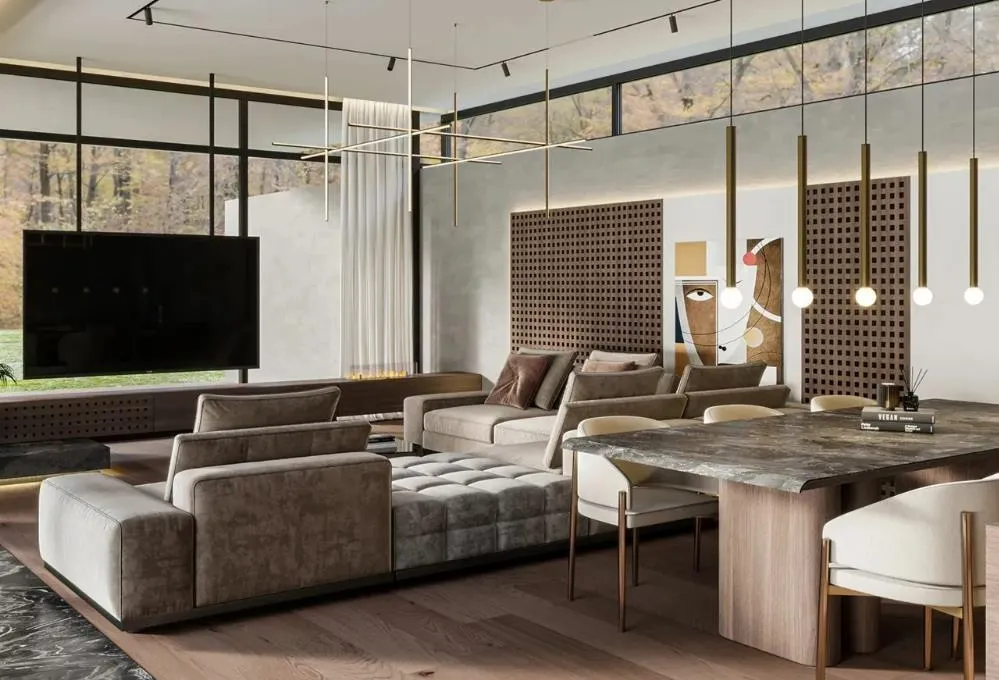The 10 most popular Japanese style design elements
Japanese style design is renowned for its emphasis on simplicity, natural elements, and tranquility. Rooted in centuries of tradition, this aesthetic focuses on creating harmonious spaces that foster relaxation and mindfulness. With an emphasis on clean lines, functional design, and high-quality craftsmanship, Japanese interiors seamlessly blend nature and minimalism. The following 10 most popular Japanese design elements highlight the core characteristics of this style, offering a perfect blend of beauty, simplicity, and functionality for modern homes.

1.Japanese interior design
Japanese interior design is characterized by simplicity, minimalism, and a deep connection to nature. It focuses on creating peaceful, functional spaces with clean lines and uncluttered layouts. Natural materials like wood, bamboo, and stone are commonly used, alongside neutral color palettes of whites, grays, and earthy tones. Sliding doors, tatami mats, and low-profile furniture enhance the sense of space and calm. Japanese design often incorporates elements of Zen philosophy, creating tranquil, harmonious environments that prioritize comfort, functionality, and balance.
2. Natural Materials
Japanese style uses a lot of natural materials, such as paper, wood, bamboo and stone. These materials not only have an environmentally-friendly texture, but they also have a warmth that can connect interior spaces with the natural world. Tatami floors, paper screens and other elements can create a comfortable and warm atmosphere.
3. Japanese style bedroom design
Japanese style bedroom design focuses on simplicity, tranquility, and natural elements. It features low-profile furniture like tatami beds or futons, with clean lines and neutral tones such as beige, white, and light wood. Sliding doors or shoji screens are common, allowing for flexible space and soft, diffused light. Minimalistic decor, such as simple artworks or bonsai plants, enhances the serene atmosphere. Natural materials like wood, bamboo, and linen are prevalent, creating a calming, clutter-free environment ideal for rest and relaxation.
4. Indoor Gardening
In Japan, gardening is not limited to outdoor spaces, and green plants are also commonly used indoors, such as potted plants, moss, and small Japanese gardens. Indoor plants can bring a natural atmosphere while adding layering and vitality to the space. Potted plants and small trees such as bamboo and pine are often the focus of the design, conveying a sense of tranquility and natural beauty.
5. Shoji
Shoji is an ancient Japanese design for doors, windows and partitions. It's usually made up of a wooden frame with translucent Japanese paper. Not only does it have aesthetic value, it can also be used to adjust indoor lighting and create a soft-shadow effect. Paper screens can be used to decorate and function in Japanese-styled rooms or homes.

6. Modern Japanese interior design
Modern Japanese interior design blends traditional elements with contemporary aesthetics, creating functional and serene living spaces. It emphasizes clean lines, minimalism, and a connection to nature, with natural materials like wood, stone, and bamboo. Neutral color palettes, such as whites, grays, and muted tones, dominate the space, while furniture is often low-profile and simple. Sliding doors, open spaces, and large windows bring in natural light, enhancing the feeling of tranquility. Modern Japanese design integrates technology subtly, ensuring comfort and efficiency without compromising its calming, minimalist aesthetic.
7.Japanese style bathroom design
Japanese style bathroom design emphasizes minimalism, tranquility, and natural materials. The layout typically features clean lines, a neutral color palette of whites, grays, and earthy tones, and materials like wood, stone, and bamboo. A deep soaking tub, often placed near a window, creates a spa-like experience. Shoji screens or frosted glass provide privacy while allowing natural light. Simple, functional accessories like wooden shelves or stone sinks add to the serene atmosphere. The design fosters relaxation, making the bathroom a calming, harmonious space.
8. Simple Color Matching (Neutral Tones)
The Japanese style is characterized by the use of natural colors and the avoidance of bright, ostentatious and overly vibrant ones. Natural tones such as wood, dark grays, off-whites, dark greens, etc. are common colors. These colors create a harmonious and peaceful space, can reduce visual distractions and help people feel relaxed and peaceful.
9. Bathroom Design (Ofuro)
In Japan, the bathroom is an important cultural space. Japanese bathroom design usually includes a deep bathtub (Ofuro) for relaxation and meditation. The decoration of the bathroom is usually very simple and neat, and wooden or stone elements are widely used. The bathroom has similarities with the traditional Japanese hot spring (Onsen), emphasizing relaxation and spiritual purification during the bathing process.
10. Japanese Traditional Crafts (Japanese Crafts)
Handicrafts are also a big part of the Japanese style. Lacquerware and pottery, as well as fabrics, woodcrafts, and other traditional Japanese crafts, are often used to finish off home designs. These crafts are not only culturally valuable, but they also create a beautiful atmosphere in the home. It doesn't matter if it is a vase made by hand or a blanket woven by hand, they can all reflect Japan's quest for exquisite craftsmanship.
Conclusion
The charm of Japanese style lies in its integration of traditional culture with modern design concepts, pursuing a simple, natural and harmonious space experience. From low furniture, Japanese-style rooms to the use of natural materials, every design element reflects the Japanese's extreme attention to space and details. Whether pursuing a simple life or a tasteful and elegant home environment, the Japanese style can provide a solution that is both beautiful and practical.
Frequently Asked Questions
1.What is the Japanese style of interior design called?
The Japanese style of interior design is often referred to as "Zen" or "Wabi-Sabi." It emphasizes simplicity, minimalism, natural materials, and harmony with nature. The design prioritizes clean lines, functional spaces, and a tranquil, uncluttered atmosphere, creating environments that promote relaxation and mindfulness.
2.What is the Japanese interior design method?
The Japanese interior design method focuses on simplicity, functionality, and a strong connection to nature. It emphasizes clean lines, minimalist furniture, and natural materials like wood, stone, and bamboo. The layout is often open, with an emphasis on fluidity and space. Key elements include sliding doors, tatami mats, and low-profile furniture, creating a serene, uncluttered environment that promotes balance, peace, and mindfulness.
3.What is a Japandi design?
Japandi design is a fusion of Japanese and Scandinavian aesthetics, blending the minimalist, serene elements of Japanese design with the functional, cozy feel of Scandinavian interiors. It emphasizes simplicity, natural materials, clean lines, and neutral colors, creating a balanced, calm, and harmonious living space that combines the best of both styles.
4.What is the difference between Chinese and Japanese interior style?
The key difference between Chinese and Japanese interior styles lies in their approach to space and decor. Chinese interiors often feature ornate details, rich colors, and intricate furniture, reflecting luxury and symbolism. In contrast, Japanese style emphasizes simplicity, minimalism, and a connection to nature, with clean lines, natural materials, and a calming, uncluttered atmosphere. Chinese interiors may be more vibrant and decorative, while Japanese design favors subtle elegance and functionality.






_1753683059938.webp)

